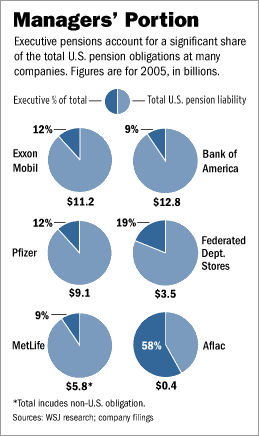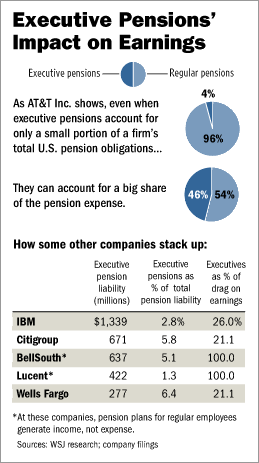(originally posted at Deny My Freedom and cross-posted at Daily Kos)
It’s become something of a narrative for the mainstream media these days: unions have caused companies to pay wages that are too high for their workers, even when they’re idle. The cost of healthcare benefits for these workers are rising, and, most importantly of all, the pensions of these workers are simply too burdensome of a liability for firms to carry on their balance sheet. Because of this, companies like General Motors, in order to stay competitive with other firms that outsource their labor elsewhere, say that they have to renegotiate contracts and offer workers a severance package. The most striking example of this has been GM and Delphi, who have been offering a package to help the latter company, a spun-off auto parts supplier for GM, emerge from bankruptcy. It’s also done in part to aid GM, which suffered a net loss of $10.6 billion in 2005.
However, this past Friday, the Wall Street Journal reported that although workers’ pensions may be expensive, there’s something that’s quite expensive itself: executive pension plans.
This is the pension squeeze companies aren’t talking about: Even as many reduce, freeze or eliminate pensions for workers — complaining of the costs — their executives are building up ever-bigger pensions, causing the companies’ financial obligations for them to balloon.
Companies disclose little about any of this. But a Wall Street Journal analysis of corporate filings reveals that executive benefits are playing a large and hidden role in the declining health of America’s pensions.

Whether or not corporate executives get paid too much – and I think they do – is a debate that will probably never be settled. However, contemplate that there are comparatively few executives when you think about the numbers of employees at these big firms. The fact of the matter is that although the number of workers causes their overall liability on a company’s balance sheet to be larger, the amount they get per worker is much, much less than retired or terminated executives will earn. Consider the inherent inequality that comes when you consider this:
But for executives, the percentage of pay replaced is itself higher. Compensation committees often aim for a pension that replaces 60% to 100% of a top executive’s compensation. It’s 20% to 35% for lower-level employees.
David Dorman was chief executive of AT&T Corp. from 2002 until its merger with SBC Communications in November. He left in January. His total of five years at AT&T earned him a yearly pension of $2.1 million. That will replace 60% of his annual salary and bonus in his final three years.
By contrast, former AT&T accountant Ralph Colotti’s $28,800 annual pension replaces 33% of his final pay. He was at the company for 33 years.
Something like this is completely unfair, as it clearly seems. Why should an executive who worked with the company for less than 4 years earn such a rich pension, while someone who was a loyal low-level employee for over 30 years earn a pension that, if he has a family to support, may not make ends meet? It boggles the mind, but it should come as no surprise given that the income gap between the wealthiest and the poorest of Americans has been increasing. The argument for the excessive pay for executives largely centers around the fact that they add much more value to the firm. However, once they quit, they are no longer actively contributing to the value-adding activities of the firm. Why should they be paid more than any former worker of the company? The plain and simple answer is that they should not. It’s unethical, to say the least, and grossly obscene.

By curtailing pensions for regular workers, large companies have reduced pension obligations to them by billions of dollars in recent years. So pension obligations to regular workers are stable or shrinking at many companies while those for executives rise. At BellSouth Corp., for example, the obligations for pensions for ordinary workers have edged down 3% since 2000. The liability for pensions for executives is up 89% over the same period. A BellSouth spokesman noted that, like many executive pensions, the benefit could be lost in the event the company becomes insolvent.
The promise of any pension becomes a corporate obligation. Although the payments are in the future, the promise means the company has a liability now. And a number can be put on it.
Since the turn of the century, there’s been a clear problem occurring – workers are promised smaller pensions, while those of executives are spiraling out of control. While this does create an increased liability, this does not mean that the true extent of the liability of executive pensions is known. This is mostly in part due to the quirky nature of accounting. Under generally accepted accounting principles (GAAP), you must capitalize (to put it on the balance sheet, which is a summation of a firm’s assets, liabilities, and equity) a liability if you can reasonably determine what future payments will be. However, as the graphic implies above, this is rarely done. Instead, executive pensions, for the most part, become part of a ‘pension expense’. In accounting terms, this is known as an ‘off-sheet liability’ – called so because it does not have to be recorded on the balance sheet. As opposed to a capitalized liability, which is amortized over a period of time, the full amount an executive receives is now expensed in the period it occurs. This shows up on the income statement, which is a periodic statement on the revenues and costs to a firm (the balance sheet is a summation of a firm’s assets, liabilities, and equity at a given point in time). This why you don’t see the pensions of executives showing up as a part of the overall liability, as the graphic above shows; instead, it is expensed immediately, lowering a firm’s earnings. New FASB (Financial Accounting Standards Board) rules adopted at the beginning of this year requires that stock-based compensation expense, a form of compensation that most executives receive (it gives the owner of an option the ability to buy a share of the company at a preset price); before, these expenses did not even have to be reported on the income statement. They were included in the footnotes to the financial statements, but they were given little attention. It’s probably a good explanation as to why you may begin to see larger dents in corporate earnings – but that’s only for the ‘salary’ an executive receives. As WSJ notes:
Even if a company’s liability for executives’ pensions totals hundreds of millions of dollars, its employees and shareholders may never know. Companies don’t have to report this obligation separately in federal financial filings. A few specify it in a footnote, and some provide clues that make it possible to derive the figure.
Speaking from the exposure I’ve had to date with accounting, deriving numbers is not an easy task. Companies have absolutely no reason to provide complete transparency when reporting numbers. Let’s take AT&T’s pension expense, for example.
At AT&T Inc., the pension liability for executives was a modest 3.8% of the company’s total pension obligation at the end of last year. Yet these promises to 1,000 or so highly paid people generated more than 45% of AT&T’s pension expense. The expense for them came to $113 million last year, and reduced AT&T’s 2005 earnings by that amount.
The other 55% of pension expense? It covered 189,000 regular employees.
For the highest-paid people at AT&T, the pension expense comes out to roughly $113,000 per executive. For regular workers, that amounts to a measly $1,328.63 per worker. You want injustice? This is injustice. You hear firms justifying outsourcing because it simply costs too much to keep workers on the payroll in the U.S. Sure, it may cost more than paying someone in a developing country to do the same job, but when the pension of workers have been declining slightly while those of executives have nearly doubled, it’s utterly deceptive to claim that it has to be done.
Furthermore, the liabilities that workers’ pensions create sometimes have a beneficial effect on the company. At GM, the pension plan for their workers generated over $10 billion in income. In other words, the company was actually increasing their value by having the pension plan in place. The executive pension plan cost GM $1.4 billion – as an unfunded, off-sheet liability, it has no ability to record income. In accounting, you cannot have an effect without a cause. In this case, the cause of the income from the pension plan is the liability that is on the balance sheet. Without a similar item to link the corporate executive pensions, there can be no income made; it will only remain an expense that keeps detracting from the profitability of the firm.
And that’s the bottom line.




